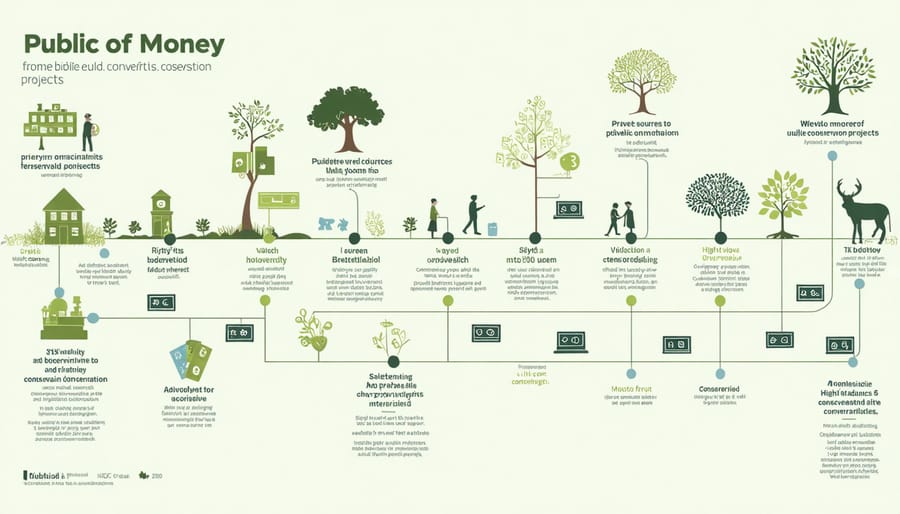Funding Nature’s Future: How Biodiversity Finance is Safeguarding Life on Earth

Imagine a world where nature thrives, where the intricate tapestry of life is not just preserved, but celebrated and nurtured. This is the vision behind biodiversity finance – a powerful tool in the fight against the escalating biodiversity crisis. By harnessing the power of financial mechanisms and innovative partnerships, we can channel much-needed resources into protecting and restoring the Earth’s most precious ecosystems.
From the lush rainforests teeming with exotic species to the vibrant coral reefs that serve as the lifeblood of our oceans, the incredible diversity of life on our planet is under threat like never before. The stakes could not be higher – the loss of biodiversity not only erodes the very foundations of nature, but also undermines the well-being of communities and economies worldwide.
But there is hope. Biodiversity finance offers a path forward, a way to mobilize the capital needed to safeguard the irreplaceable marine biodiversity facts and terrestrial treasures that sustain us all. From impact investing and green bonds to biodiversity offsets and payment for ecosystem services, a wealth of innovative financial instruments are being developed to drive positive change.

The Biodiversity Crisis
Drivers of Biodiversity Loss
Biodiversity loss is driven by a multitude of factors, with habitat destruction being a primary culprit. As human populations expand and encroach upon natural habitats, ecosystems are fragmented and degraded, leaving countless species without the resources they need to survive. Climate change, fueled by greenhouse gas emissions, exacerbates this issue by altering temperature and precipitation patterns, causing shifts in species’ ranges and disrupting delicate ecological balances. Overexploitation, such as unsustainable fishing practices and poaching, directly depletes populations of targeted species. Pollution, including plastic waste and chemical runoff, contaminates ecosystems and harms wildlife. The introduction of invasive species can also disrupt native communities and contribute to biodiversity loss, as explored in invasive species: the hidden threat destroying our ecosystems. Moreover, ocean acidification, caused by increased absorption of atmospheric carbon dioxide, threatens marine biodiversity by impacting the ability of calcifying organisms to build their shells and skeletons. Addressing these drivers requires a concerted effort from governments, businesses, and individuals to promote sustainable practices and protect critical habitats.
Consequences of Biodiversity Loss
The loss of biodiversity has far-reaching consequences that extend beyond the ecological realm. As species disappear and ecosystems unravel, we face a cascade of impacts that threaten the very foundations of our existence. Economically, the loss of biodiversity undermines the services that nature provides, such as pollination, pest control, and water filtration, which are essential for agriculture and other industries. This, in turn, can lead to reduced crop yields, increased costs, and economic instability. Socially, the loss of biodiversity erodes the cultural heritage and traditional knowledge of communities that have long relied on nature for their livelihoods and well-being. It also diminishes the aesthetic and recreational value of our landscapes, depriving future generations of the opportunity to experience the wonders of the natural world. Ultimately, the consequences of biodiversity loss are a stark reminder of the urgent need for action to protect and restore the richness of life on Earth.
What is Biodiversity Finance?

Public Funding
Government funding plays a crucial role in biodiversity conservation, with many countries allocating resources to protect ecosystems and species. Foreign aid from developed nations also supports conservation efforts in biodiversity-rich developing countries. Multilateral agreements, such as the Convention on Biological Diversity and the Global Environment Facility, facilitate international cooperation and funding for biodiversity projects. These agreements set targets, provide financial mechanisms, and encourage technology transfer to support conservation initiatives worldwide. However, public funding for biodiversity remains inadequate, with estimates suggesting that current investments fall short of what is needed to effectively protect and restore ecosystems. Governments and international organizations must scale up their financial commitments and explore innovative financing mechanisms to bridge the biodiversity funding gap and ensure the long-term sustainability of our planet’s precious natural heritage.
Private Sector Investment
The private sector plays a crucial role in financing biodiversity conservation efforts. Businesses are increasingly recognizing the importance of investing in nature, not only for its intrinsic value but also for the long-term sustainability of their operations. Impact investors, who seek to generate positive social and environmental outcomes alongside financial returns, are channeling funds into projects that protect and restore ecosystems. Green bonds, which are debt instruments specifically designed to support environmental initiatives, have emerged as a popular tool for financing biodiversity projects. By investing in these bonds, private investors can contribute to large-scale conservation efforts while potentially earning a return on their investment. As more companies and investors realize the economic benefits of preserving biodiversity, such as reducing risks associated with resource scarcity and climate change, private sector investment in this area is expected to grow, providing much-needed capital to restore ocean health and protect the planet’s precious ecosystems.
Innovative Financing Mechanisms
Case Study 1: Seychelles’ Debt-for-Nature Swap
In 2018, the Republic of Seychelles, an archipelago nation in the Indian Ocean, took a groundbreaking step towards protecting its marine biodiversity by restructuring a portion of its national debt. Through a debt-for-nature swap, the Seychelles government agreed to exchange $21.6 million of its debt for increased marine conservation efforts. The deal, facilitated by The Nature Conservancy (TNC) and other partners, allowed the Seychelles to redirect debt payments into a trust fund dedicated to financing conservation projects, sustainable fisheries, and climate change adaptation.
As part of the agreement, the Seychelles committed to protecting 30% of its territorial waters, an area spanning 410,000 square kilometers (158,000 square miles). This ambitious goal involves the creation of new marine protected areas (MPAs), the expansion of existing ones, and the implementation of sustainable management practices. The debt restructuring not only supports the Seychelles’ efforts to safeguard its unique marine ecosystems but also serves as a model for other nations facing the dual challenges of debt and environmental conservation. By aligning economic interests with ecological imperatives, the Seychelles’ debt-for-nature swap demonstrates the potential for innovative financing mechanisms to drive meaningful change in marine biodiversity conservation.

Case Study 2: Costa Rica’s Payments for Ecosystem Services
Costa Rica’s pioneering Payments for Ecosystem Services (PES) program, established in 1997, has become a model for biodiversity finance worldwide. The program incentivizes landowners to protect and restore forests by compensating them for the ecosystem services their lands provide, such as water regulation, carbon sequestration, and biodiversity conservation. Landowners who enroll in the program receive payments based on the type and size of their forest, as well as the ecosystem services it provides. The funds for these payments come from a variety of sources, including a fuel tax, water fees, and international donations. Since its inception, the PES program has helped Costa Rica increase its forest cover from 21% in the 1980s to over 50% today, making it one of the few countries to reverse deforestation. The program has also benefited biodiversity by providing habitat for countless species, including many endemic and threatened ones. By demonstrating that economic incentives can effectively promote conservation, Costa Rica’s PES program has inspired similar initiatives around the world and shown that investing in nature can yield significant ecological, social, and economic returns.
Challenges and Opportunities
Measuring and Valuing Biodiversity
Measuring and valuing biodiversity poses significant challenges due to the complex and multifaceted nature of ecosystems. Quantifying the benefits of biodiversity requires the development of standardized metrics that account for both tangible and intangible values. These metrics must consider factors such as ecosystem services, species richness, genetic diversity, and cultural significance. However, the lack of universally accepted methods for measuring biodiversity and assigning monetary values to its components has hindered progress in this field. To effectively prioritize conservation efforts and allocate resources, it is crucial to establish a common framework for assessing biodiversity’s value. This framework should incorporate ecological, economic, and social dimensions, enabling decision-makers to make informed choices that balance human needs with the preservation of the natural world. By developing robust and widely accepted metrics, we can better understand the true value of biodiversity and create more effective strategies for its protection and sustainable management.
Aligning Incentives
Creating economic incentives is crucial for aligning short-term interests with long-term biodiversity conservation goals. One approach is to establish payment for ecosystem services (PES) schemes, where landowners or communities receive financial compensation for protecting and managing ecosystems that provide valuable services, such as carbon sequestration or water filtration. Another strategy is to develop biodiversity offset programs, which require developers to invest in conservation projects to compensate for the biodiversity loss caused by their activities. Governments can also implement tax incentives and subsidies to encourage sustainable practices and discourage activities that harm biodiversity. Additionally, promoting sustainable tourism and eco-labeling can create market demand for biodiversity-friendly products and services, incentivizing businesses to adopt more sustainable practices. By aligning economic incentives with conservation objectives, we can encourage individuals, communities, and businesses to value and protect biodiversity, ensuring its preservation for future generations.
Conclusion
Biodiversity finance is a critical tool in the fight to protect and preserve the incredible diversity of life on Earth. By mobilizing financial resources and creating innovative funding mechanisms, we can support conservation efforts, restore degraded ecosystems, and ensure the long-term sustainability of our planet’s natural heritage. The various instruments and approaches discussed in this article, such as biodiversity offsets, payment for ecosystem services, and green bonds, demonstrate the potential for creative solutions that align economic incentives with conservation goals.
However, the challenges facing biodiversity finance cannot be overlooked. Inadequate funding, lack of political will, and the complexities of valuing and monetizing ecosystem services remain significant hurdles. To overcome these obstacles, we must foster greater collaboration between governments, businesses, financial institutions, and conservation organizations. By working together, sharing knowledge, and developing best practices, we can scale up biodiversity finance and maximize its impact.
Ultimately, the success of biodiversity finance depends on our collective commitment to protecting life on Earth. We must recognize that investing in nature is not just a moral imperative but also an economic necessity. By safeguarding biodiversity, we secure the foundation for human well-being, sustainable development, and a thriving global economy. It is time for all stakeholders to step up and prioritize biodiversity finance as an essential tool in the fight against the global biodiversity crisis. With increased investment, innovation, and collaboration, we can build a future where people and nature thrive together.
